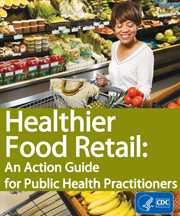Healthier Food Retail (HFR) Action Guide
 Healthier Food Retail: An Action Guide for Public Health Practitioners [PDF-7.8MB] provides guidance for public health practitioners on how to develop, implement, and partner on initiatives and activities around food retail to improve access, availability, and affordability of healthier foods and beverages. With this guide, public health practitioners can begin or enhance their work in healthier food retail.
Healthier Food Retail: An Action Guide for Public Health Practitioners [PDF-7.8MB] provides guidance for public health practitioners on how to develop, implement, and partner on initiatives and activities around food retail to improve access, availability, and affordability of healthier foods and beverages. With this guide, public health practitioners can begin or enhance their work in healthier food retail.
The primary audience for the guide is state-level public health practitioners, particularly those working in nutrition and obesity prevention. However, the guide is also intended to be useful to practitioners at regional and community levels, with many action items and examples applicable at these levels.
This Action Guide is unique in that it is organized around public health roles, particularly at the state level; these include facilitating partnerships, conducting assessments, providing technical assistance, or coordinating the work of local public health or communities.
You can download the entire guide [PDF-7.8MB], or select individual chapters below:
Front Matter and Introduction [PDF-936KB]
ncludes notice to readers, acknowledgements, table of contents, purpose and audience for the guide, rationale for the guide, how to use the guide, and organization of the guide.
Chapter 1: Partnerships, Assessment, and Evaluation [PDF-1.2MB]
Focuses on partnership development and includes two partnership activities often conducted with partners – assessment and evaluation.
Chapter 2: Grocery Stores [PDF-936KB]
escribes strategies that encourage full service grocery stores to locate in underserved areas or that support existing stores in supplying and marketing healthier items.
Chapter 3: Small Stores [PDF-919KB]
escribes improving small stores in underserved areas to increase the accessibility and promotion of healthier foods.
Chapter 4: Farmers Markets [PDF-1.1MB]
rovides information on developing new farmers markets and supporting existing markets, with emphasis on providing nutrition assistance program benefits at the markets.
Chapter 5: Mobile Food Retail [PDF-726KB]
escribes developing initiatives to encourage healthier mobile food retailers operate in underserved areas.
Chapter 6: Transportation [PDF-632KB]
iscusses options for developing safe and viable transportation options for people to travel to healthier food retail venues.
Chapter 7: Distribution [PDF-815KB]
ffers strategies for sourcing and distributing healthier foods for retail venues, including local or regional foods.
Appendix A [PDF-244KB]
rovides a table of evaluation questions, indicators, and data sources for healthier food retail strategies.
- Page last reviewed: September 18, 2015
- Page last updated: September 18, 2015
- Content source:


 ShareCompartir
ShareCompartir